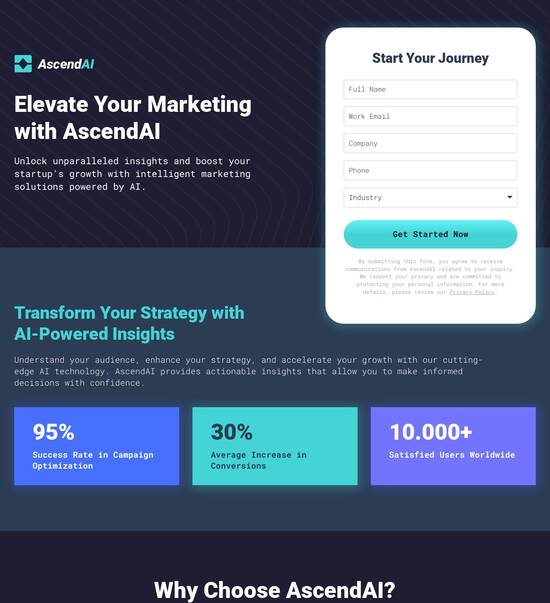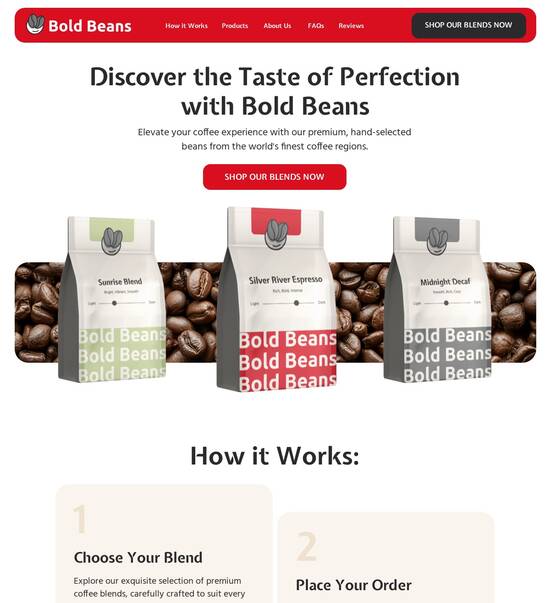
HTML page template for financial technology companies
Use TemplateAbout template
Give your financial technology companies a boost with our professional landing page templates. Ready to turn visitors into customers?
Recommended templates

Easy to build without coding
With the intuitive drag-and-drop builder, anyone on your team can create high-converting pages without any knowledge of code or design. Make enhancements to your landing page with custom widgets using Javascript, HTML/CSS, or third-party scripts.

Multiple layouts for any industry and goal
Select from 500+ landing page layouts built to boost conversions across industry-specific scenarios. Customize them by adjusting fonts, adding images, and generating on-brand content with the AI assistant. Quickly scale with Instablocks® and Global Blocks that you can save, reuse, and update globally.

Loads fast and looks polished on any device
Every template is responsive, which means they present professionally on any device and load blazingly fast with our Thor Render Engine. You can also power them up with Google AMP technology to deliver an unparalleled mobile experience and drive higher conversions.

Robust analytics & experimentation
Get real-time updates and reporting across all your devices, showing the number of visitors, conversions, cost-per-visitor, and cost-per-lead. Launch AI-powered experiments, run A/B tests, and use heatmaps to analyze user behavior, then optimize your landing page to maximize conversions.







Easy to build without coding
With the intuitive drag-and-drop builder, anyone on your team can create high-converting pages without any knowledge of code or design. Make enhancements to your landing page with custom widgets using Javascript, HTML/CSS, or third-party scripts.
Multiple layouts for any industry and goal
Select from 500+ landing page layouts built to boost conversions across industry-specific scenarios. Customize them by adjusting fonts, adding images, and generating on-brand content with the AI assistant. Quickly scale with Instablocks® and Global Blocks that you can save, reuse, and update globally.
Loads fast and looks polished on any device
Every template is responsive, which means they present professionally on any device and load blazingly fast with our Thor Render Engine.
Robust analytics & experimentation
Get real-time updates and reporting across all your devices, showing the number of visitors, conversions, cost-per-visitor, and cost-per-lead. Launch AI-powered experiments, run A/B tests, and use heatmaps to analyze user behavior, then optimize your landing page to maximize conversions.
All the features you need to build lead-generating landing pages
Explore more featuresLearn how to build top-performing landing pages for any goal
FAQs
Leading the way in building high-performing landing pages





A step-by-step guide to optimizing your marketing campaigns with Instapage
Harnessing the power of Instapage's landing page creation tools offers marketers a strategic advantage in maximizing their campaign ROI. With features designed specifically for versatile industries, including tech, education, and financial services, businesses can quickly adapt and elevate their marketing strategies.
Understanding the importance of landing pages
Landing pages serve as the first point of contact for prospective customers. They are specifically designed to drive conversions and capture leads by providing targeted content that resonates with each audience segment. This focused approach ensures that marketing messages are clear and actionable.
- Enhanced conversion rates: Specialized landing pages can significantly improve conversion rates by targeting specific audiences.
- Streamlined user experience: Instapage simplifies navigation and content layout, ensuring a seamless user journey.
- Data-driven results: Utilize built-in analytics to assess your landing page's performance effectively.
Step 1: Choose the right template
Selecting a high-converting template tailored to your industry is crucial for the success of your campaign. Instapage offers over 100 professionally designed templates that cater to various sectors, ensuring relevance and appeal.
- Industry-focused designs: Select templates specifically crafted for your niche to resonate with your audience.
- Customizable elements: Use pre-built lead generation forms and adjust design elements to fit your brand identity.
- Mobile-responsive layouts: Ensure your landing pages are accessible and visually appealing across all devices.
Step 2: Optimize for conversions
Maximize your landing pages' effectiveness through optimization techniques. Instapage includes tools to conduct A/B testing, assess user behavior via heatmaps, and track key performance indicators.
- A/B testing capabilities: Test different headlines, visuals, or call-to-action buttons to discover what resonates best with your audience.
- Heatmaps for insights: Analyze where visitors click and scroll to refine your content presentation.
- Analytics dashboard: Measure conversion rates, bounce rates, and other essential metrics to inform your strategy.
Step 3: Personalize user experiences
Creating personalized experiences not only engages users but also drives higher conversion rates. Use dynamic text replacements and AdMaps within Instapage to tailor content to different audience segments.
By accommodating the unique preferences of your audiences, you can deliver the right message at the right time, increasing your marketing effectiveness.
Get started with Instapage today to transform your landing page strategy and achieve remarkable results.
HTML page template for financial technology companies
Understanding the demand for HTML page templates in financial technology
The financial technology (FinTech) sector has experienced remarkable growth over the past two decades, revolutionizing how financial services are delivered. Companies in this space have emerged driven by innovation in payment systems, investment strategies, and personal finance management. As technology continues to advance, FinTech companies increasingly rely on robust digital user interfaces and a strong online presence to engage customers effectively. This transition emphasizes the importance of tailored user experiences that are not only visually appealing but also functionally efficient.
In this context, understanding and utilizing HTML page templates becomes crucial for FinTech firms. An HTML page template serves as a foundational framework designed to streamline the web development process, allowing companies to focus on what matters—delivering exceptional financial services. With a well-crafted template, businesses can create distinct online identities while ensuring consistency and reliability across web platforms.
The core features of HTML page templates for FinTech companies
One of the standout features of modern HTML page templates is responsive design. It's critical for FinTech companies to provide an optimal viewing experience regardless of device, as users now access services from various platforms including mobile phones, tablets, and desktop computers. Responsive design ensures that webpages adapt seamlessly to different screen sizes, enhancing user experience and satisfaction. This adaptability not only boosts engagement but also significantly influences conversion rates, as users are less likely to abandon a site that functions well on their chosen device.
Complementing responsive design, customizable layouts form another key element of HTML page templates for FinTech firms. These pre-designed page layouts are specifically crafted for financial services and often come equipped with drag-and-drop features. This simplicity allows users, even those without extensive coding knowledge, to modify content and structure to meet their individual business needs. Flexibility in templates is invaluable as it enables businesses to pivot quickly and adapt to changing market dynamics and user preferences.
Responsive design ensures an optimal viewing experience across devices.
Customizable layouts allow for easy modifications and brand alignment.
An integral aspect of these templates is CSS integration. CSS plays a crucial role in enhancing both the aesthetic appeal and functionality of a webpage. Through CSS customizations, FinTech companies can mirror their brand's identity, ensuring that their web presence is consistent with their overall marketing strategy. Furthermore, applying appropriate CSS strategies can enhance cross-browser compatibility, allowing users to access financial services seamlessly, irrespective of the browser in use.
Additionally, user-centric features like interactive charts and graphs present visual data effectively. For FinTech, where data representation is paramount, the right choice of charts can simplify complex financial information for users. Such interactive elements not only enhance the user experience but also improve engagement rates, making the information more digestible for a diverse audience.
Enhancing visibility and user experience
To ensure that users can find their web pages, HTML page templates must include SEO-optimized elements. This starts with the inclusion of meta tags and structured data that enhance visibility on search engines. FinTech companies can implement strategies such as keyword integration to enhance their rankings for relevant terms. A well-optimized template can lead to increased organic traffic, allowing businesses to connect more effectively with their target audience.
Another essential consideration is speed and performance optimization. The loading times of webpages can significantly impact user retention and conversion rates. Optimized HTML templates can minimize HTTP requests and leverage modern technologies like content delivery networks (CDNs). Companies that prioritize speed are likely to retain users, as page load times directly correlate with user satisfaction.
SEO-optimized elements improve organic search visibility.
Performance optimization is crucial for retaining users.
Using CDNs can reduce loading times significantly.
Implementing aesthetic features in templates
When designing HTML templates, adherence to native design standards is crucial for FinTech companies. Following industry best practices helps maintain a professional appearance and builds credibility with users. Additionally, aspects such as visual hierarchies can influence user engagement. Proper utilization of whitespace and alignment contributes to achieving a clean and organized layout, making it easier for users to navigate and find information.
Integrating graphics and multimedia elements is another effective strategy. FinTech firms should focus on best practices for incorporating relevant images and videos that communicate important information swiftly. Animated elements can be particularly useful in explaining complex concepts, while infographics play a major role in improving user comprehension and retention of information.
Adhere to industry best practices for a professional appearance.
Utilize whitespace and alignment for an organized layout.
Employ infographics to enhance user comprehension.
Customization capabilities and unique requirements
FinTech companies often have unique requirements based on their regulatory needs or specific market niches. Choosing tailored templates that address these aspects can provide businesses with a distinct advantage. For instance, templates designed specifically for cryptocurrency platforms or robo-advisors can help streamline compliance processes while ensuring that branding remains consistent. Compliance and flexibility play a significant role in the overall effectiveness of a page template.
Another important consideration is ensuring that templates cater to high-resolution displays, such as retina screens. Ensuring that graphics and layouts are optimized for high-DPI devices guarantees that users see clear, crisp visuals. This can enhance the overall user experience, reflecting positively on the brand's perception.
Choose templates tailored to specific financial services for compliance.
Optimize graphics for high-resolution displays for better user experience.
User testing and feedback integration
Gathering user insights is key to refining HTML page templates and ensuring they meet user expectations. Various tools and methods can help collect feedback, revealing which features resonate with users and which need adjustments. A/B testing serves as an invaluable method in this process, allowing FinTech companies to compare different landing page designs, ultimately leading to optimized results. Moreover, employing analytics tools like heat maps and session recordings can provide detailed insights into user behavior on webpages.
Iterative design strategies ensure that HTML templates evolve based on user feedback and industry trends. As technology advances and market dynamics shift, it is essential for FinTech companies to react accordingly, updating their templates to address these changes and maintain relevance. This proactive approach can set businesses apart in a competitive landscape.
Utilize A/B testing to compare landing page designs.
Analyze user behavior with heat maps for deeper insights.
Iterate designs based on feedback and market trends.
Future trends in HTML page templates for FinTech
As technology continues to advance, artificial intelligence (AI) is playing an increasingly integral role in customizing HTML templates. AI tools can predict user preferences, enabling FinTech companies to create highly personalized experiences that cater to individual user needs. This personalization is especially valuable within the competitive market, where satisfying customer expectations can lead to greater loyalty and retention.
Emerging technologies, such as voice search and chatbots, are impacting web design. FinTech companies need to prepare HTML templates to accommodate these trends, ensuring that user interactions are seamless if input via voice commands. With voice-activated interfaces increasingly being used, tapping into this trend can give innovative companies a competitive edge.
Moreover, sustainability is gaining traction in all sectors, including FinTech. The growing demand for green technologies is prompting companies to adopt eco-friendly practices. Developing energy-efficient HTML templates can not only align with these market expectations but also boost a brand's reputation as socially responsible.
AI can enhance template customization and user personalization.
Preparing templates for voice search is vital for future marketing strategies.
Adopt eco-friendly practices to align with consumer expectations.
Conclusion and next steps in template development
In conclusion, the insights provided in this article highlight the critical areas that FinTech companies should prioritize when developing HTML page templates. The demand for exceptional user experiences, combined with rapid technological advancements, necessitates continuous learning and adaptation. Companies that invest in sophisticated HTML templates stand to benefit not only their brand image but also foster consumer trust and loyalty.
By focusing on the user-centric design, ensuring performance optimization, and staying ahead of emerging trends, FinTech companies will position themselves effectively in the digital marketplace. The journey towards enhancing user experiences with refined HTML page templates is ongoing, and companies must remain proactive in their approach to stay relevant in an ever-evolving industry landscape.
Ready to skyrocket conversions?
Supercharge your ad campaigns with high-performing landing pages
Get started














